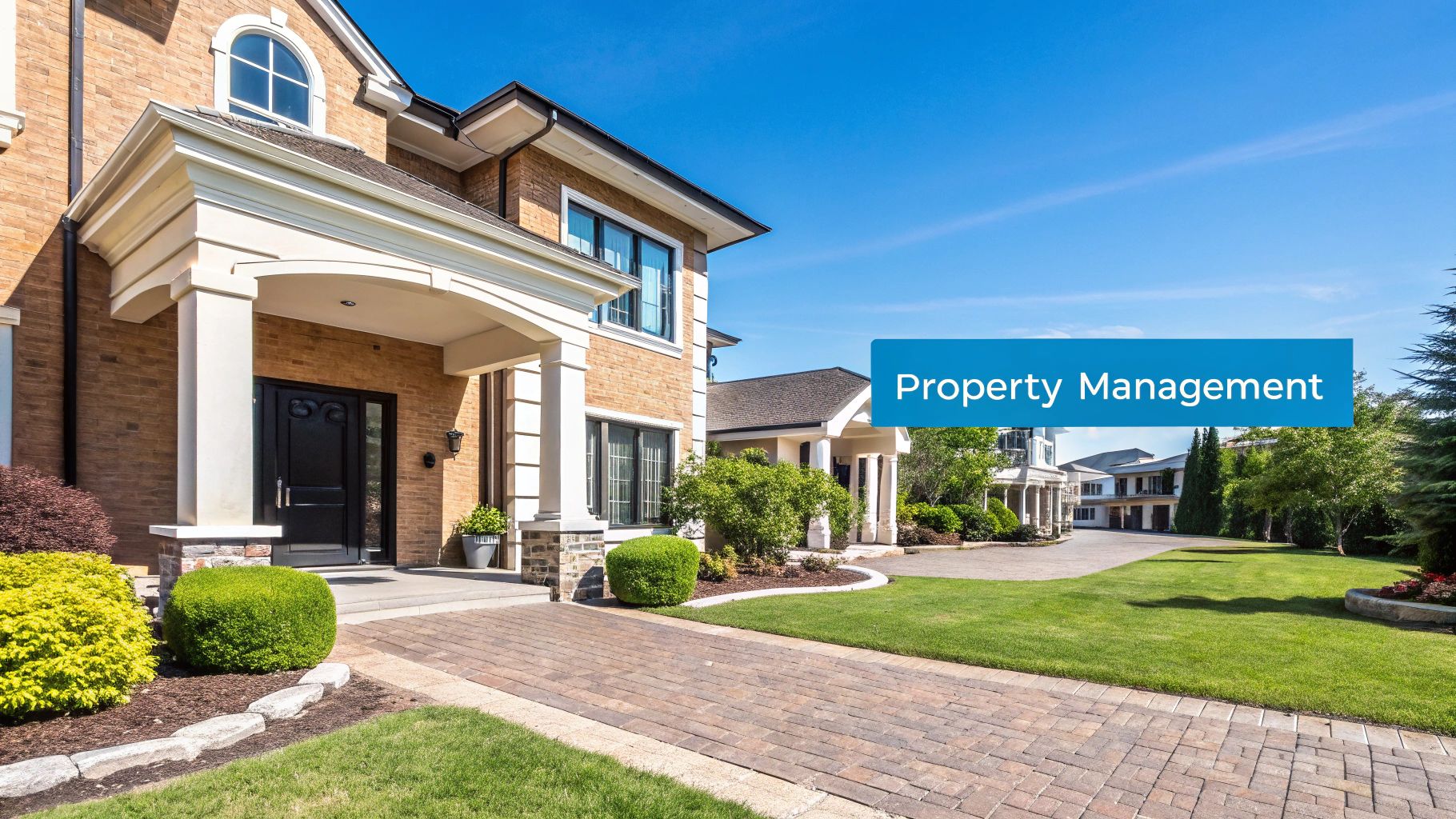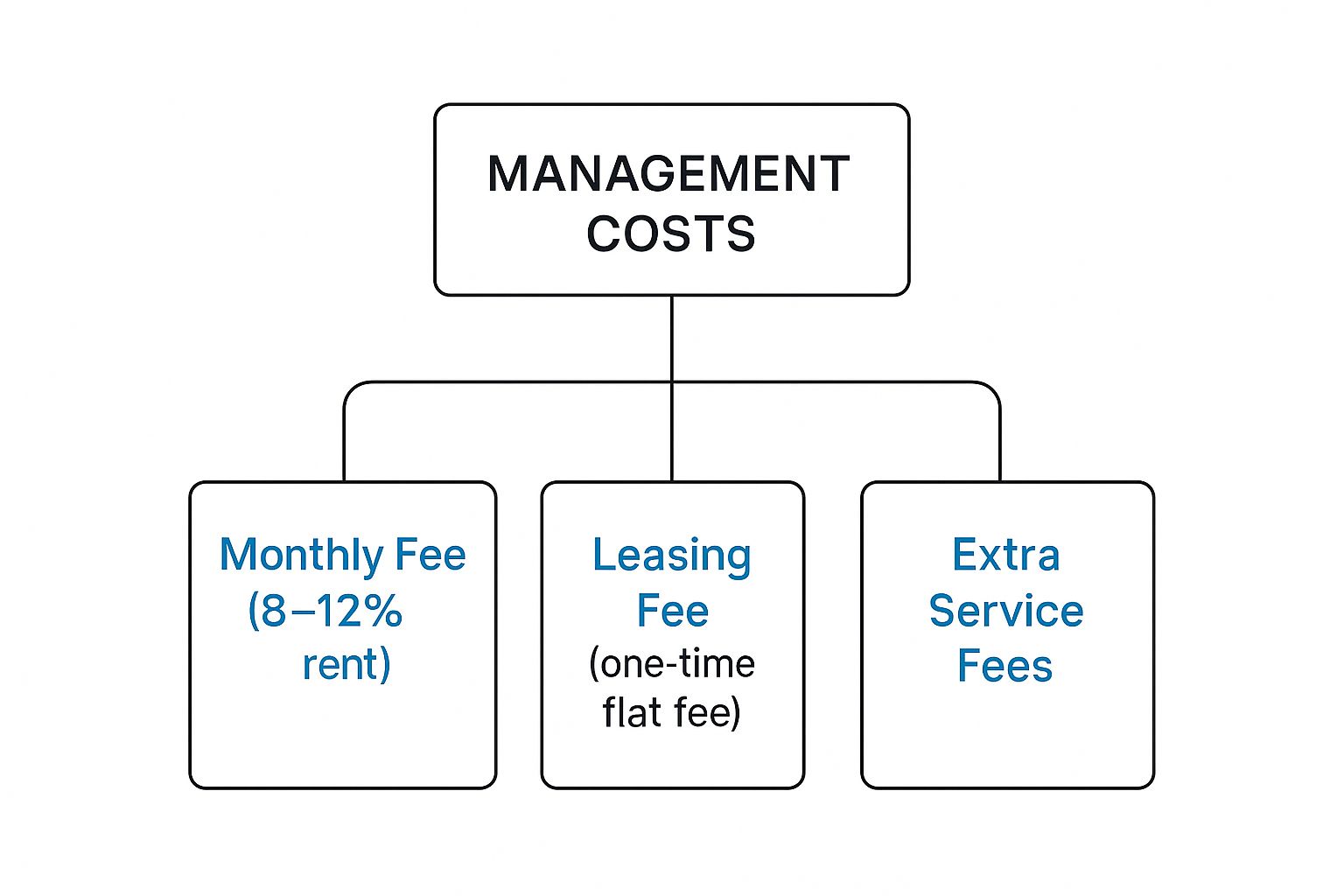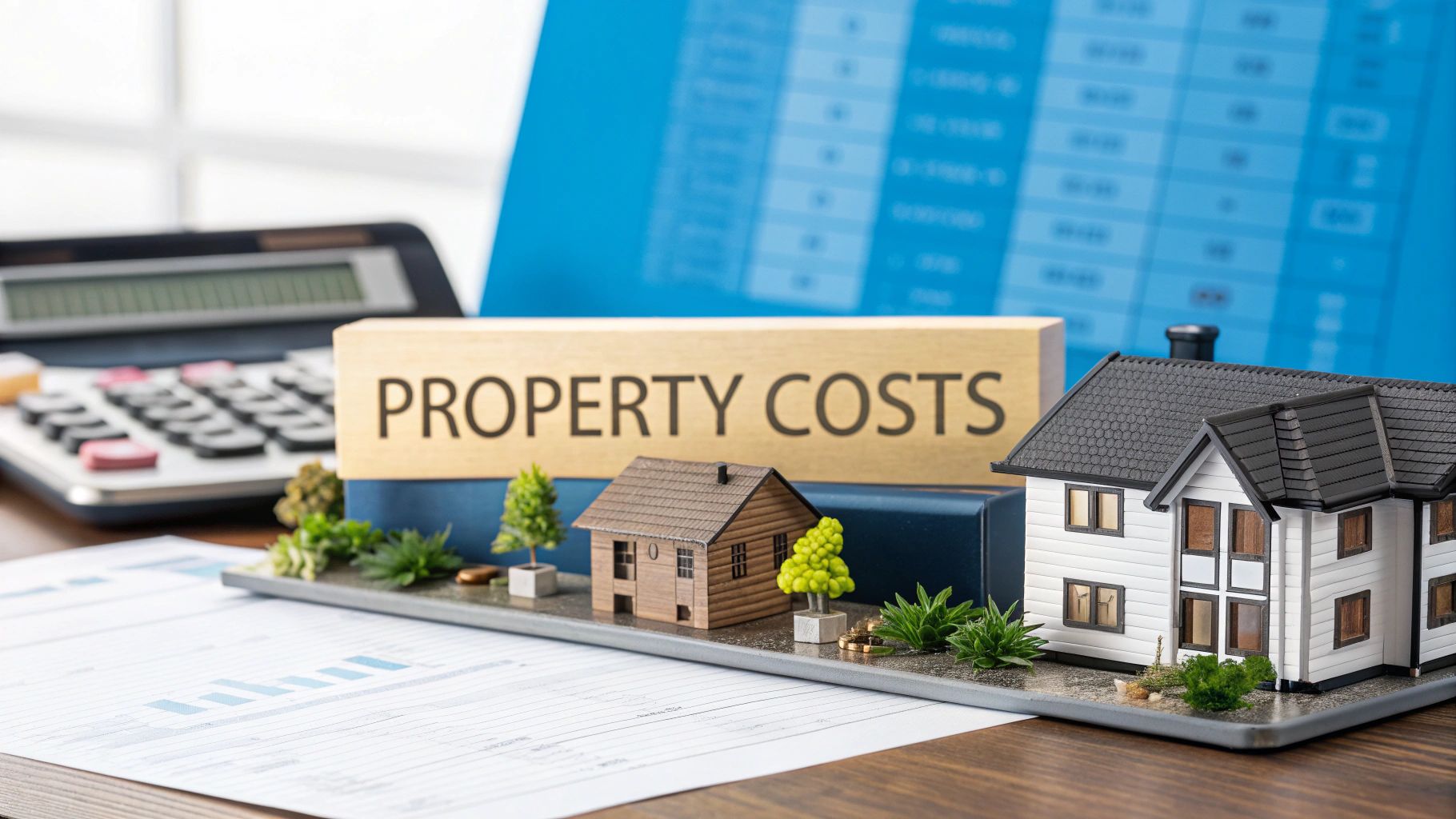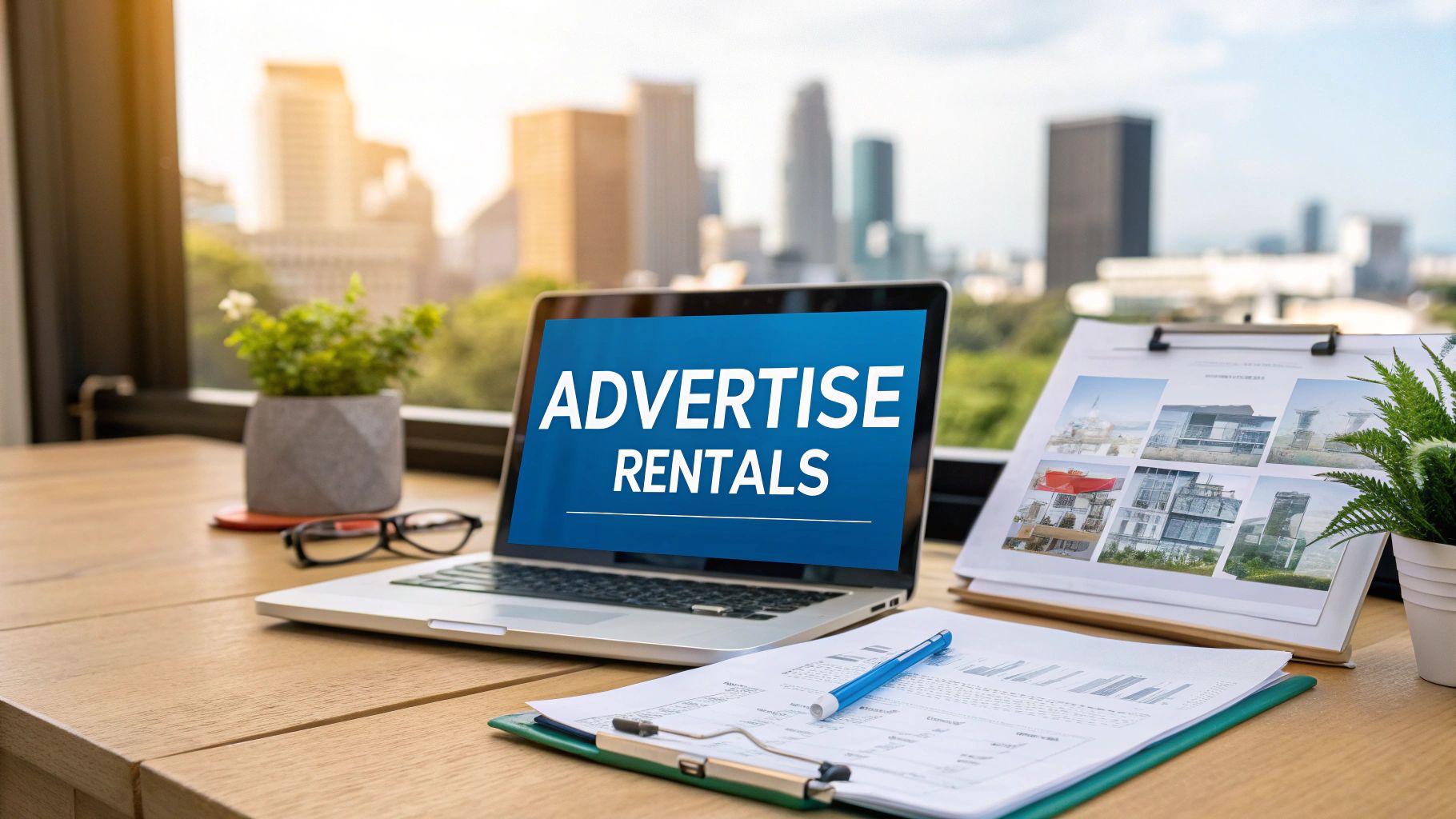How much does property management cost? For a standard residential property, the typical answer is 8% to 12% of the monthly rent or a flat fee of $100 to $200 per month.
But when you're managing a portfolio of hundreds or thousands of units, that simple answer is dangerously incomplete.
The True Cost of Managing Large Rental Portfolios

For large-scale operators, the conversation around cost shifts from a simple percentage to a deep dive into operational efficiency and its impact on revenue. The sticker price on a management contract is just a single data point. The real metrics that matter are cost per door and the impact on your most critical KPIs: Days on Market (DOM) and lead-to-tour conversion rates.
The question isn't just "how much is it?" but "how does this investment reduce vacancy loss and accelerate our speed-to-lease?"
This strategic mindset is essential in today's market. The global property management market is expanding rapidly, reflecting the increasing complexity and opportunity within the industry. You can explore more about these property management statistics and what they mean for your portfolio's future.
To help you navigate the options, here's a quick breakdown of the most common fee structures you'll encounter.
Quick Guide to Property Management Fee Structures
This table summarizes the typical fee models for residential properties, helping you see at a glance what might work best for your portfolio.
Each model has its place, but for enterprise-level operations, the real value is found by looking past the fee itself and focusing on the results it delivers.
Beyond Fees to Financial Performance
Thinking in terms of cost per door and revenue per unit provides a much clearer picture of your portfolio's financial health. A slightly higher management fee becomes an easy decision if it leads to a measurable drop in Days on Market (DOM) or a significant lift in your lead-to-tour conversion rate.
After all, every day a unit sits vacant is a direct hit to your revenue—a cost that can quickly dwarf any management fee.
At scale, just a 5-day reduction in vacancy across a 1,000-unit portfolio can translate into hundreds of thousands of dollars in recovered annual revenue. The focus must be on partners and systems that drive speed-to-lease.
That’s why evaluating property management costs requires a holistic, ROI-driven view. You need to dissect the fee structure, but more importantly, you must weigh the provider's ability to boost your operational velocity and support your growth from a few hundred units to several thousand.
Instead of getting hung up on the expense, center your analysis on the total financial impact. The best management solutions don't just administer properties—they optimize asset performance and accelerate revenue generation.
Breaking Down Common Property Management Fee Models
When you're scaling a portfolio, you quickly learn that not all fee structures are created equal. The way your property manager charges isn't just a line item; it's a critical factor that can either align with your growth or create significant friction. Getting this right is key to forecasting revenue and ensuring your management partner is as motivated as you are to keep units filled.
Generally, management costs boil down to three main buckets: the ongoing monthly management fee, a one-time leasing fee for placing a new tenant, and any ancillary service fees.

This breakdown shows where your money is going—covering the day-to-day management, the upfront work of finding tenants, and any other services you might need.
The Percentage of Rent Model
This is the classic approach where the property manager takes a cut of the monthly rent, usually between 8% and 12%. It's calculated from the gross collected rent each month.
The primary upside is that your manager's incentives are directly tied to yours. They make more money when your properties are occupied and achieving market-rate rent. This model naturally pushes them to minimize vacancies and secure competitive rental rates.
However, for a large portfolio spread across different markets with varying rents, this model can make forecasting a challenge. Your management expenses will fluctuate with your rental income, making it difficult to establish a stable, predictable cost per door.
The Flat-Fee Management Model
For operators managing hundreds or even thousands of doors, the flat-fee model is all about one thing: predictability. You pay a set dollar amount per unit, every month, regardless of the rent collected.
This makes budgeting and financial modeling significantly easier at scale. You know your exact management cost per door, which allows for laser-focused expense tracking and performance analysis across your entire portfolio. All the guesswork tied to rent fluctuations is eliminated.
For enterprise operators, the flat-fee structure isn't just a convenience—it's a strategic necessity. When you're managing thousands of units, predictable costs are the bedrock of scalable growth.
Hybrid and Per-Door Pricing Models
Sometimes, a one-size-fits-all approach doesn't work. A hybrid model cherry-picks elements from both the percentage and flat-fee structures. For instance, a company might charge a low flat fee for basic management but add a percentage-based commission for new leases or renewals. This can be a great fit for portfolios with a mix of property types and needs.
Ultimately, there’s no single "best" model. The right choice depends entirely on your portfolio's makeup and your growth strategy. The goal is to land on a structure that provides financial clarity and supports your ability to scale, not one that adds unpredictability. A sound fee model should feel like a true partnership—one that helps you slash your Days on Market (DOM) and boost the performance of your assets.
Looking Beyond the Monthly Fee: The Hidden Costs in Management Contracts

That monthly management fee on the proposal? Think of it as the tip of the iceberg. To truly understand "how much is property management," you must dig into the fine print and uncover the full range of ancillary—or "à la carte"—fees within the contract.
These charges can quietly accumulate and seriously impact your portfolio's bottom line. What appears to be a competitive rate can quickly erode your margins if you're not careful. For enterprise-level operators, these seemingly small line items multiply rapidly across thousands of units, making a thorough contract review non-negotiable. Missing one could lead to unexpected expenses that derail budgets and eat into your net operating income. Getting these details right is crucial for an accurate cost per door calculation.
Common "À La Carte" Fees to Look For
When combing through a management agreement, keep your eyes peeled for these common charges. Each one represents a potential cost that needs to be factored into your overall analysis.
- Tenant Placement & Leasing Fees: This is a major one, typically running from 50% to 100% of the first month's rent. It covers marketing, tenant screening, and lease execution. For large portfolios, this is a prime area for negotiation.
- Lease Renewal Fees: Some companies charge a flat fee, perhaps $200-$400, or a small percentage each time a lease is renewed with a desirable tenant.
- Maintenance Coordination Markups: It’s standard practice for managers to add a markup, typically around 10%, to vendor invoices for coordinating repairs. It's vital to know the exact figure.
- Eviction Processing Fees: If an eviction is necessary, the manager will likely charge a flat fee of $300-$600 plus court costs for managing the administrative and legal legwork.
- Vacancy Fees: This is a major red flag. Be wary of any contract that allows a manager to charge a fee even when the property is empty. It completely misaligns incentives and penalizes you for the manager's inability to lease the unit quickly.
These practices aren't just local; they're global. The property management market is a massive industry with widespread operational models. You can dive deeper into the research on the global property management market to see these trends for yourself.
The best management agreements are built on transparency and aligned goals. If a fee structure penalizes you for vacancies or, even worse, rewards the manager for high tenant turnover, it’s a bad sign for any large-scale operation focused on long-term asset health.
Ultimately, a detailed contract review is your best defense. It ensures total cost transparency before you sign, preventing costly surprises down the road. This diligence helps you build a true partnership that supports your portfolio's financial goals instead of quietly undermining them.
How Portfolio Scale and Technology Drive Down Costs
When you’re managing a large portfolio, the question “how much is property management?” stops being about a fixed percentage. It’s a completely different conversation—one centered on efficiency, scalability, and cost per door. A savvy operator with 2,000 units will almost always secure a better per-door rate than an owner with 20. Why? Because scale fundamentally changes the cost equation.
There are key variables that directly impact management quotes, and understanding them provides a significant advantage. The size of your portfolio is the most obvious lever; more doors mean more bargaining power. But geographic density is equally important. Managing 500 units in one neighborhood is far more streamlined than managing 500 single-family homes scattered across three counties. The first allows for operational efficiency; the second creates a logistical nightmare.
Technology as a Cost-Reduction Engine
But the real game-changer today? Technology. A modern PropTech stack automates the high-volume, repetitive tasks that consume manual labor and drive up operational costs.
For enterprise operators, technology isn't just a nice-to-have; it's the core of cost-per-door optimization. Automating lead responses and tour scheduling creates massive operational leverage that justifies a lower management fee.
This isn't just a hunch; it’s an industry-wide shift. Investing in the right technology has become essential for running an efficient, scalable operation.
Before we go further, let's break down the main factors that will shape the management fee you're quoted.
Key Factors Influencing Your Management Quote
The final number on your proposal isn't arbitrary. It’s a calculation based on how efficient (or inefficient) your portfolio is to manage. Here’s what a potential partner is weighing.
Ultimately, these factors all boil down to one thing: how much work is your portfolio going to be? The more you can do to reduce that workload through scale and technology, the better your rate will be.
Connecting Efficiency to Your Bottom Line
A smart, integrated tech stack does more than save time. It directly impacts your bottom line by shrinking the leasing cycle. When you automate tour scheduling or instantly reply to every lead, you slash your Days on Market (DOM) and get leases signed faster.
That operational speed is a powerful negotiating tool. When you can show a potential partner that your systems will make their job easier, you have a rock-solid case for a lower fee. You can explore a comprehensive guide to property management tech to see how these tools can streamline operations.
By investing in the right automation, you’re not just optimizing workflows; you’re building a more profitable and scalable machine. Learn more about how to improve property management operations with the right systems. Your technology choices give you the power to negotiate from a position of strength and boost your entire portfolio's performance.
Calculating the True ROI of Professional Management

It's time to stop talking about property management fees as just another expense. For large-scale operators, that monthly fee isn't a cost center—it's a strategic investment designed to maximize asset performance.
The real value isn’t found on an invoice. It’s measured by its impact on the metrics that drive revenue: lower vacancy rates, higher lead conversion, and accelerated speed-to-lease. To see the true return on investment (ROI), you must look past the fee and quantify the financial gains from shorter Days on Market (DOM) and improved tenant retention.
This is how you justify management costs as a driver of scalable growth.
A Practical ROI Framework for Large Portfolios
Let’s run a quick calculation to illustrate the massive revenue impact of operational speed.
Imagine a portfolio of 1,000 units with an average rent of $1,800 a month. Every day a unit sits empty, it's costing you $60 in lost revenue ($1,800 / 30 days).
Now, what if your management partner implemented new technology that shaved just five days off your average DOM per vacancy?
- Revenue Gained Per Unit: 5 days x $60/day = $300
- Total Annual Revenue Recovered (Portfolio-wide): $300 x 1,000 units = $300,000
In this scenario, a simple five-day improvement in leasing velocity generates an additional $300,000 in annual revenue. That gain alone can easily eclipse the total annual management cost, proving the fee is an investment with a clear, positive return.
The core principle for enterprise operators is that speed-to-lease is a primary revenue driver. Every operational efficiency that shaves a day off your DOM translates directly to your bottom line, making the management fee a performance-based investment.
Beyond Vacancy Reduction
While leasing velocity is critical, a full ROI analysis must account for all the ways a top-tier management partner adds value. These factors are just as crucial to your net operating income and long-term asset health.
You should also factor in:
- Increased Tenant Retention: Reducing turnover by just 5% across a large portfolio can save tens of thousands in marketing, leasing fees, and unit turn costs.
- Optimized Maintenance Spend: Proactive maintenance and strong vendor relationships reduce expensive emergency repairs and extend the life of major systems.
- Time Savings for Your Team: An effective management partner frees up your internal team to focus on strategic growth initiatives instead of being bogged down by day-to-day operational fires.
By putting real numbers to these benefits, you can build a powerful business case for your management spend. For more ideas, check out our guide on 8 ways to boost ROI for your properties. This data-driven approach shifts the conversation from cost to a strategic discussion about maximizing portfolio performance.
Optimizing property management costs shouldn't mean settling for inferior service. For large-scale operators, it's not about finding the cheapest percentage fee. The real goal is to extract maximum value from every dollar spent, turning management expenses into a tool that directly boosts your portfolio's bottom line.
The smartest place to start? Your scale. When you're negotiating for a portfolio with hundreds or thousands of units, you're in the driver's seat. Use that leverage to secure better terms, but don't just fixate on the management percentage. Push for service level agreements (SLAs) that cover the metrics that actually matter, like lead-to-tour conversion rates and your overall speed-to-lease.
Standardize and Automate for Real Efficiency
If you're operating across multiple markets, standardization is non-negotiable. It’s the only way to ensure every property, whether in one city or ten, operates on the same high-performance playbook.
This is where technology provides a decisive advantage. By automating the high-volume, repetitive tasks that bog down your team, you can slash operational drag and drive improvements across your most important KPIs.
The objective is to shift your entire operation from reactive to proactive. Stop just managing vacancies and start actively shrinking your Days on Market (DOM) with a systemized, tech-driven leasing funnel.
Here are a few practical steps you can take right now:
- Automate Tour Scheduling: Eliminate the endless email and phone tag. Allow qualified leads to book their own showings instantly, improving the prospect experience and getting units seen faster.
- Centralize Your Lead Management: Funnel all inbound leads into a single platform. This ensures no lead is missed and empowers your team to engage with promising prospects immediately.
- Systemize Property Inspections: Standardized checklists and consistent reporting are absolutely critical for protecting asset quality at scale. To dig deeper, check out the benefits of professional property walkthroughs and see how they safeguard your investments.
When you focus on these operational upgrades, the conversation changes. You move away from simple cost-cutting and into true value creation. You’ll stop asking "how much does property management cost?" and start measuring its direct, positive impact on your revenue.
Common Questions on Property Management Fees
When you're managing a massive portfolio, the standard fee structures just don't apply. Let's break down some of the most common questions that come up for enterprise-level operators.
What’s a Normal Leasing Fee for a Big Multifamily Portfolio?
Forget the old "one month's rent" rule. When you're dealing with hundreds or thousands of units, you have the leverage to negotiate something much better. Your volume is your biggest asset.
It’s far more common to land a flat fee per unit, which usually falls somewhere between $250 to $500. Another popular option is a reduced percentage, like 50% of the first month's rent. This kind of deal recognizes the steady stream of leasing activity your portfolio generates.
How Do Fees for Single-Family Rentals and Multifamily Differ at Scale?
The biggest difference boils down to one thing: density. Single-family rental (SFR) portfolios are usually spread out geographically, which means more windshield time and logistical headaches. Because of that, their management fees tend to be a bit higher, typically in the 8-12% range.
On the other hand, large multifamily properties are a model of efficiency. Everything is centralized in one location. This operational density allows for lower per-door fees, often dropping to 4-7%, simply because the cost and effort to manage each additional unit are much lower.
Are There All-Inclusive Property Management Fee Models?
They exist, but they're not the norm. Some management companies do offer all-inclusive or guaranteed-rate packages. The idea is you pay a higher flat monthly fee, and in return, it covers most of the extra services like tenant placement and coordinating routine maintenance.
But you have to be careful and read the fine print.
An "all-inclusive" model is only as good as its exclusions list. Always dig into what isn't covered. Major repairs, big capital improvements, or the legal costs of a tricky eviction are almost always billed separately.
Doing your homework here is non-negotiable. It helps you get a true picture of your total expenses and avoids those nasty surprises that can throw your entire portfolio's budget off track.
Ready to stop treating your leasing operations like a cost center and start turning them into a revenue driver? Showdigs gives you the AI-powered automation and on-demand agent network to slash your Days on Market, boost your lead-to-tour conversions, and scale your portfolio without the friction. See how we help enterprise property managers perfect their leasing funnel by visiting https://showdigs.com.







